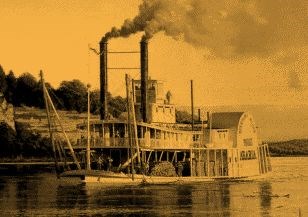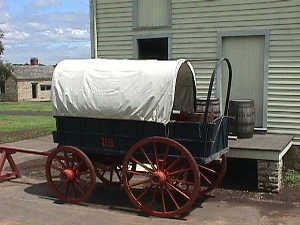|
Between 1842 and 1853, the major routes of transportation which affected the operation of Fort Scott were the Missouri River and the military road. The majority of the supplies that were necessary to build and maintain the fort were transported by steamboats on the Missouri River from St. Louis to Fort Leavenworth and then they were transported in freight wagons to Fort Scott by way of the military road. 
By the 1840s, there was regular steamboat traffic on the Missouri River between Fort Leavenworth, Westport (Kansas City) and St. Louis, except during the winter when the river was closed by ice. The river was very difficult to navigate because it was extremely shallow and the current constantly changed the depth and location of the shipping channel. The use of steamboats as a means of transportation was very practical and economical, but it was also very dangerous. Two of the most common causes of steamboat disasters were the explosion of the vessel's boilers from excessive pressure, and colliding with submerged logs which penetrated the hull of the vessel and caused it to sink. 
The primary means of overland transportation in the 1840s was accomplished by the use of domesticated animals (oxen, horses, and mules), wagons, carts and miscellaneous wheeled vehicles. The oxen, draft horses and mules were normally used to pull the heavy freight wagons (Conestoga, Murphy, and Halladay) that transported large quantities of supplies and materials. The smaller vehicles (road wagons, carts, and Dearbon wagons) were pulled by lightweight horses which could also be used for riding. The blacksmith, wheelwright, farrier, harness maker, and saddler were the principle trades that were necessary to maintain the wagons and animals that were used in overland transportation. In the larger cities, each tradesman normally had his own shop or business, but on the frontier one man was often skilled in many trades (i.e. blacksmith, farrier, and wheelwright). The blacksmith produced tools, nails, hinges, and other necessary items from iron and steel. A farrier was a blacksmith who specialized in shoeing horses, oxen and mules. The wheelwright was a specialist who made wagon wheels of all sizes and could often make an entire wagon. The harness maker and saddler were tradesmen who produced different types of leather saddles, bridles, halters, and harness that were necessary for the proper efficient use of the appropriate animals. Information for this section came from an article written by an anonymous staff member at Fort Scott National Historic Site |
Last updated: July 17, 2016
